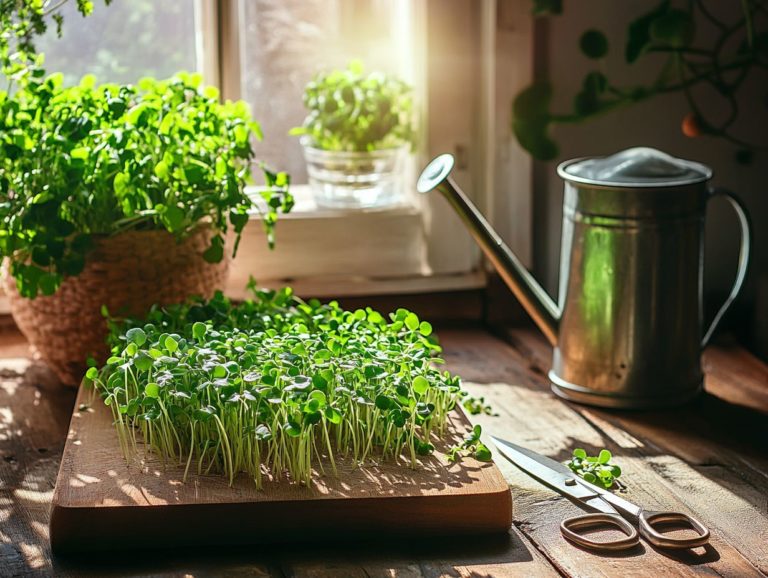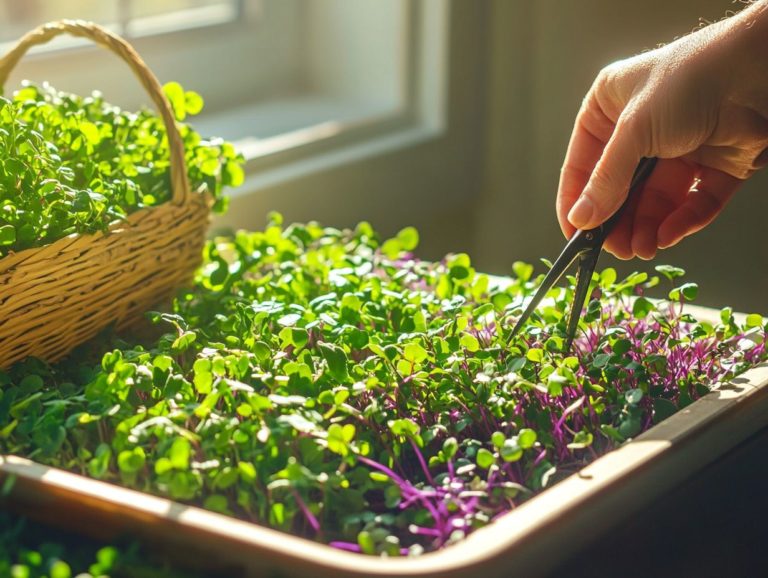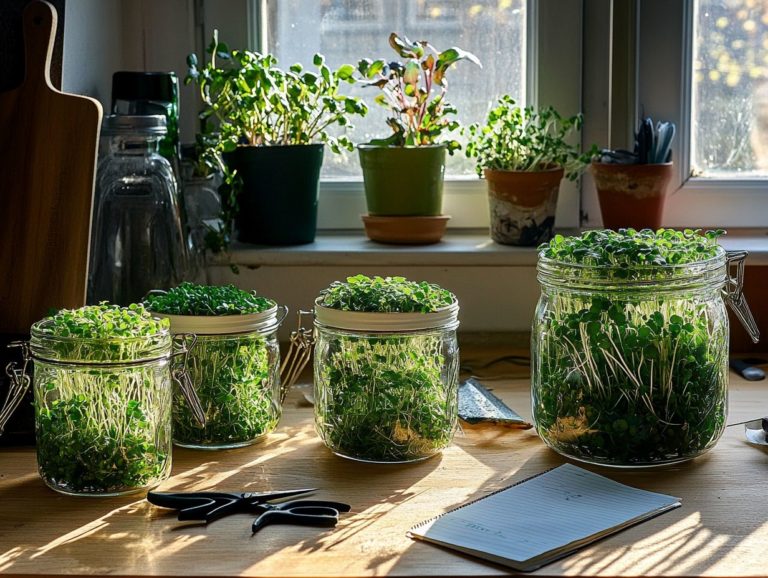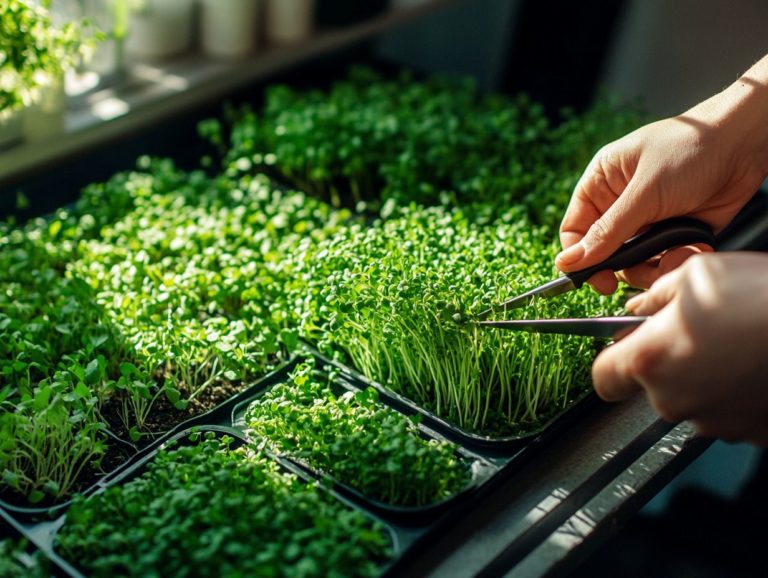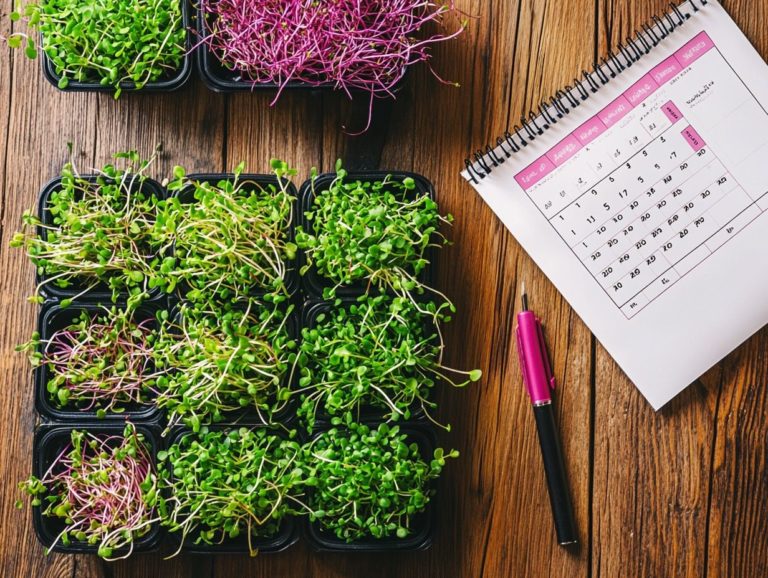How to Store Microgreens in the Refrigerator
Microgreens are tiny, nutrient-packed powerhouses that bring a burst of flavor to your dishes. They are a go-to for chefs and health aficionados alike.
Once you have harvested or purchased these vibrant greens, the next question is how to keep them fresh and appealing. You will find a step-by-step storage guide, tips for preserving their freshness, and creative ways to incorporate them into your meals. Everything you need to truly enjoy these delightful additions to your diet is right here. Don t let your microgreens wilt! Follow these tips to keep them fresh and thriving!
Contents
- Key Takeaways:
- Benefits of Storing Microgreens in the Refrigerator
- Properly Storing Microgreens in the Refrigerator
- Tips for Maintaining Freshness
- Using Stored Microgreens
- Common Mistakes to Avoid
- Frequently Asked Questions
- What are microgreens and how should they be stored in the refrigerator?
- Can I freeze microgreens for long-term storage, and how do I retain freshness?
- How do I know if my microgreens have gone bad and what harvesting techniques should I use?
- Should I wash microgreens before storing them in the refrigerator?
- Can I store different types of microgreens together in the same container?
- Are there any special storage tips for specific types of microgreens?
Key Takeaways:
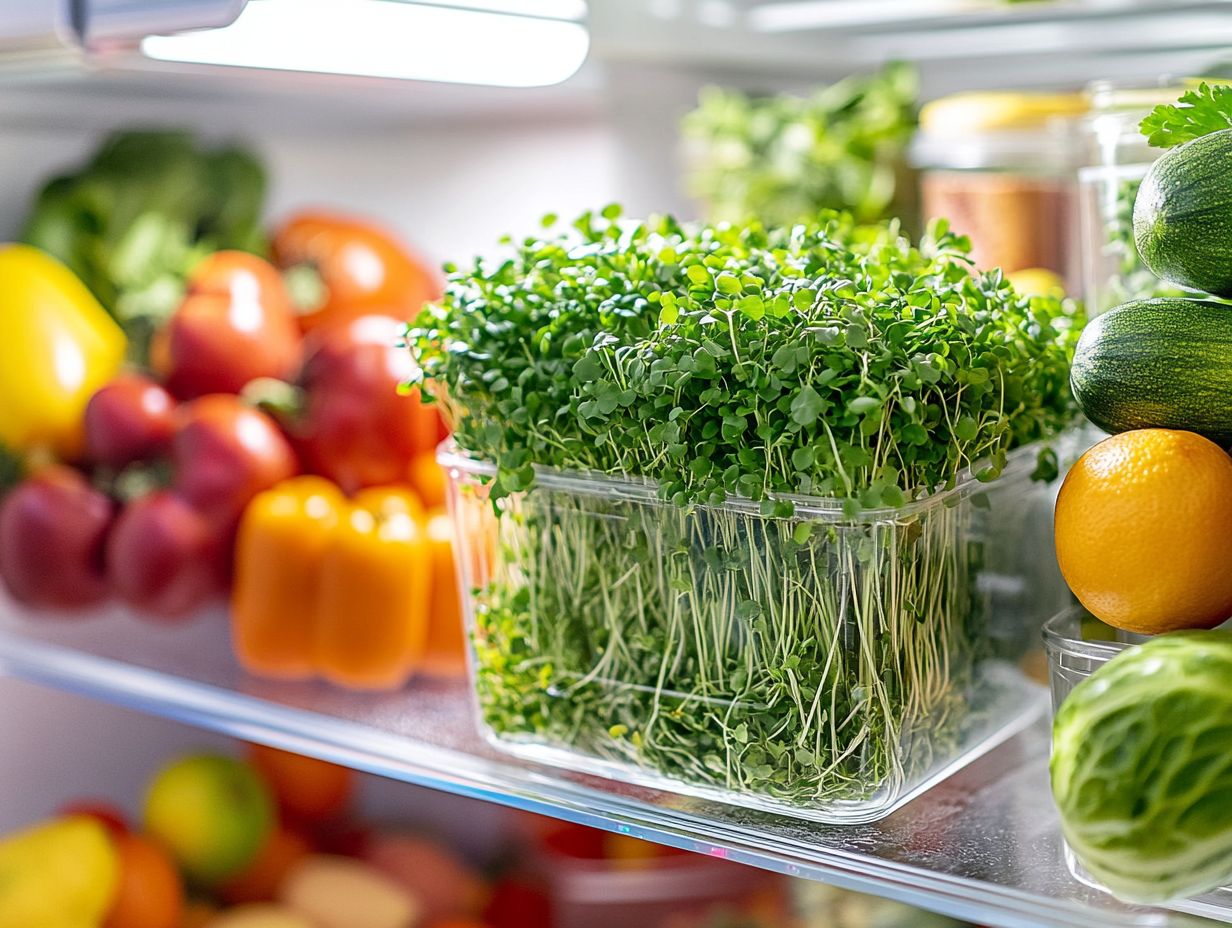
- Extend shelf life and preserve nutrients by storing microgreens in the refrigerator.
- Follow proper handling and storage techniques, such as using a paper towel and breathable container, to keep them fresh.
- Incorporate stored microgreens into meals for added flavor and nutritional benefits.
What are Microgreens?
Microgreens are young, edible plants that you harvest just after the first true leaves have emerged. They present a vibrant palette of flavors and colors. These nutrient-dense greens include peashoots, basil, broccoli, cabbage, kale, amaranth, radishes, and sunflower. They are now popular due to their exceptional nutritional benefits and versatility.
Usually grown in soil or using water and nutrients (hydroponically), microgreens thrive in well-drained, nutrient-rich environments. They take only a few weeks to reach their harvest stage. These tender sprouts aren’t just a feast for the eyes; they are bursting with vitamins, minerals, and antioxidants. Understanding the impact of humidity on microgreen storage makes them an ideal choice for the health-conscious.
You will find these tiny greens widely used in salads, sandwiches, and as garnishes, where they elevate flavors and enhance presentations. Varieties like mustard and radish deliver a delightful spicy kick, while others, such as basil and cilantro, bring a fresh aroma that enriches the overall dining experience.
Benefits of Storing Microgreens in the Refrigerator
Storing microgreens in the refrigerator not only extends their shelf life but also preserves their nutritional benefits. This method ensures that delicate greens, such as peashoots and basil, retain their vibrant flavors and beneficial properties for extended periods. You can enjoy their freshness and health benefits whenever you desire.
Extended Shelf Life and Nutrient Preservation
The extended shelf life of microgreens when stored in the refrigerator is largely due to effective moisture control and optimal temperature management. This helps these delicate greens maintain their nutritional value over time. For example, microgreens like kale and broccoli can stay fresh longer in controlled environments.
To ensure these vibrant greens thrive, it’s crucial to keep them at temperatures between 32 F and 41 F (0 C to 5 C). This temperature range significantly reduces bacterial growth and oxidation. For optimal storage, consider using appropriate containers as outlined in our complete guide to microgreens storage containers. Keeping the humidity level around 90% enhances their longevity, preventing excess moisture that could lead to decay while keeping them crisp.
By understanding these specific conditions, you can create the perfect environment for microgreens, ensuring their taste and nutritional properties are preserved for longer. For optimal results, it’s important to know the best storage temperature for microgreens, making them a must-have for your meals.
Properly Storing Microgreens in the Refrigerator

Storing microgreens in the refrigerator correctly is essential for keeping them fresh. Use suitable containers, like plastic ones, that promote effective air circulation while reducing moisture build-up.
Techniques such as layering with paper towels can help manage moisture, ensuring your greens retain their quality for as long as possible.
Try these methods today and enjoy fresh microgreens in your meals!
Step-by-Step Guide
To effectively store your microgreens, follow this step-by-step guide on gentle handling and proper storage methods. This ensures your greens stay fresh and flavorful. Start by carefully washing and drying your microgreens before transferring them to a suitable storage container.
Once cleaned, gently pat the microgreens dry with a clean kitchen towel or a paper towel. Be mindful not to crush those delicate leaves. After drying, choose an airtight container made of glass or plastic. For more detailed advice, check out these tips for washing and storing microgreens. This will help minimize moisture and keep your microgreens crisp.
Consider layering paper towels between the microgreens in the container to absorb excess moisture and prevent wilting. If you’re storing them in the fridge, place the container in the vegetable drawer, which typically offers a more stable temperature.
Keep your stored microgreens away from direct airflow to help them retain their vibrant color and texture. Regularly check for any signs of spoilage to ensure your greens remain fresh and ready to enhance any dish.
Tips for Maintaining Freshness
To maintain the freshness of your microgreens, follow a few essential tips. Focus on proper handling techniques and managing moisture levels to prevent spoilage.
By controlling external moisture and creating ideal storage conditions, you can enjoy your microgreens at their best taste.
Proper Handling and Storage Techniques
Gentle handling and effective storage methods are key to extending the shelf life of your microgreens. Techniques like moisture control and air circulation enhance the freshness and quality of your greens.
One effective strategy is to use breathable containers such as perforated plastic bags or mesh baskets. These promote airflow while keeping humidity at bay. To ensure the best quality, consider the best methods for storing microgreens and store them in the refrigerator, ideally between 34 F and 38 F, to slow decay. Lining storage containers with paper towels can absorb unwanted moisture.
Careful handling during harvesting and transferring keeps your microgreens intact. Isolating them from strong odors helps maintain their unique flavor. To ensure you understand their longevity, check out understanding microgreen shelf life and follow these practices to enjoy your microgreens longer and at their best!
Using Stored Microgreens
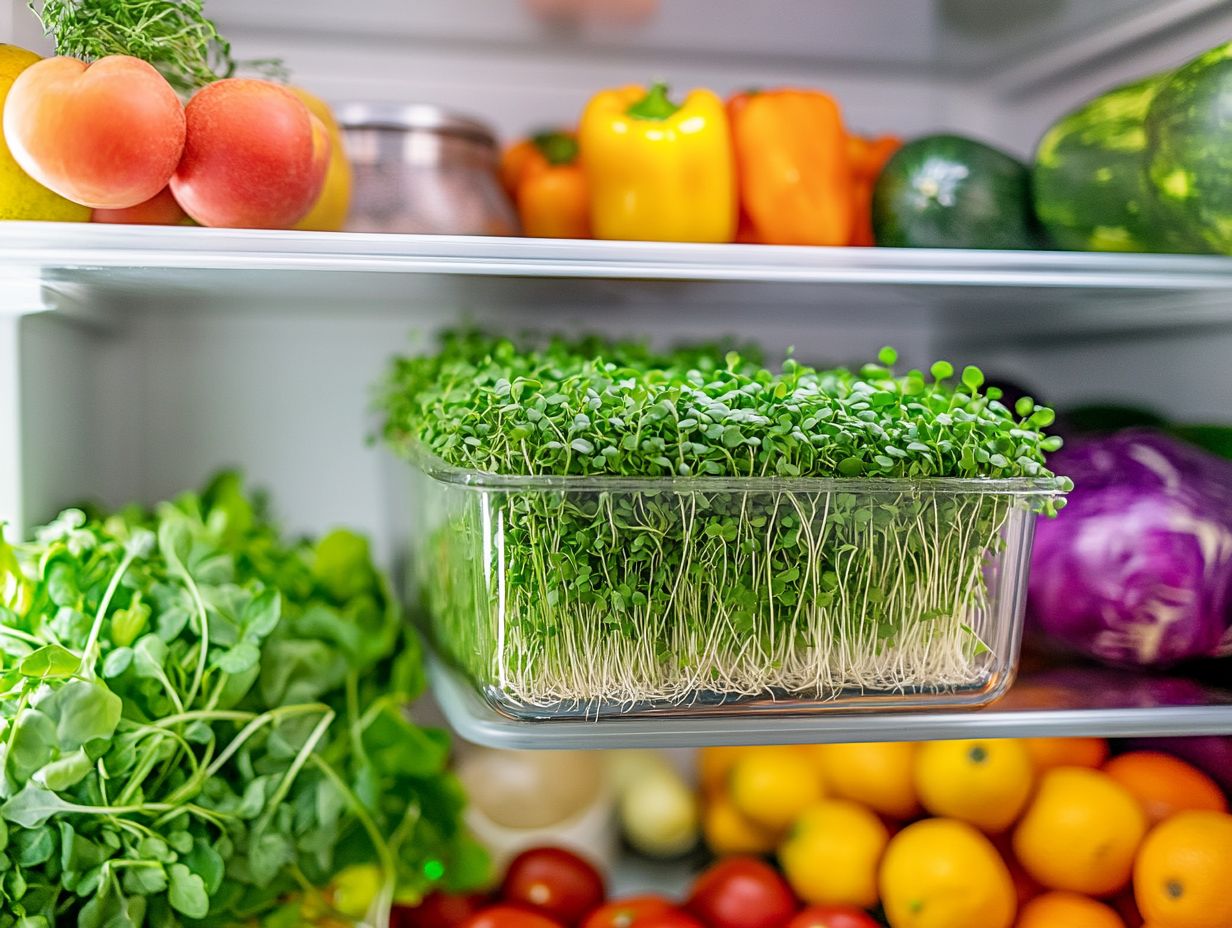
Using stored microgreens can elevate your meals. They offer fantastic nutritional benefits and are a versatile addition to various dishes.
Whether you’re crafting a fresh salad or assembling a gourmet sandwich, microgreens enhance both the flavor and presentation of your culinary creations.
Ways to Incorporate into Meals
Microgreens can be seamlessly added to many meals, infusing them with flavor, texture, and visual appeal. They work especially well in salads, sandwiches, and as eye-catching garnishes.
Imagine elevating a fresh green salad by tossing in some peppery arugula microgreens or adding the subtly sweet touch of sunflower shoots. This creates a delightful contrast that dances on the palate.
For sandwiches, layer in radish microgreens for a crunchy kick, or basil microgreens for a burst of herbaceous richness. As garnishes, delicate pea shoots enhance the presentation of soups and entr es while bringing a refreshing taste.
By exploring these unique varieties, you can elevate your culinary creations. Make each meal a visually stunning and flavorful experience.
Common Mistakes to Avoid
Avoiding common mistakes in handling and storing microgreens is crucial for preserving their quality. This allows you to savor the finest flavors and nutritional benefits.
Even minor errors can lead to rapid spoilage, making it essential to prioritize proper storage practices.
How to Prevent Spoilage and Maintain Quality
To prevent spoilage and maintain the exquisite quality of your microgreens, it’s essential to adopt effective storage techniques and ways to control moisture that will keep them fresh for an extended period. Understanding the conditions that can lead to spoilage will significantly enhance your microgreen experience.
Begin by harvesting your microgreens at the optimal time, ideally in the morning when moisture levels are naturally lower. After harvest, handle them with care by gently rinsing them in cool water to eliminate any soil residue. Then, pat them dry with a paper towel to remove excess moisture, which can encourage mold growth. For more tips, refer to the best practices for storing microgreens in the refrigerator.
For storage, choose containers that let air flow, perhaps lined with a damp paper towel, to help regulate humidity. Store them in a cool, dark place or in the refrigerator, ideally between 32 F and 40 F, to enhance their longevity. By consistently monitoring these storage conditions, you’ll ensure that your delicate greens retain their vibrant color and nutrient-rich quality. For more detailed advice, check out storing microgreens: tips for freshness. This allows you to enjoy the full benefits of your microgreens.
Frequently Asked Questions
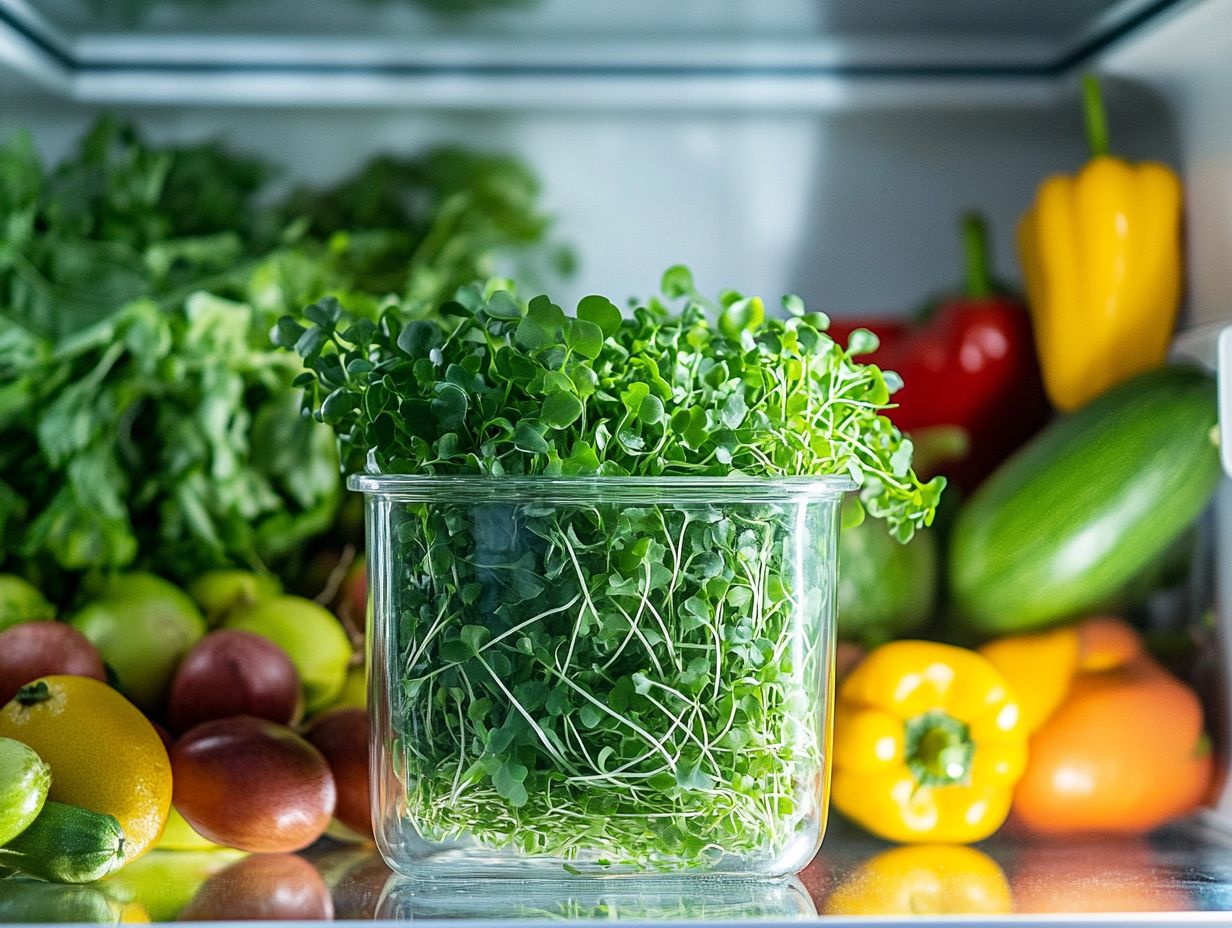
What are microgreens and how should they be stored in the refrigerator?
Microgreens are young vegetable greens that are harvested when they are only a few inches tall. They are packed with nutrients and are commonly used in salads, sandwiches, and as garnishes. To store microgreens in the refrigerator, follow these steps:
- Remove any packaging or ties from the microgreens.
- Gently rinse the microgreens under cold running water and pat them dry with paper towels.
- Place the microgreens in an airtight container or a plastic bag.
- Store the container or bag in the vegetable crisper drawer of your refrigerator.
- Make sure to use the microgreens within 3-5 days for optimal freshness and to help retain internal moisture.
Can I freeze microgreens for long-term storage, and how do I retain freshness?
While it is possible to freeze microgreens, the quality and texture may be compromised once they are thawed. It is best to consume microgreens fresh for the best taste and texture. If you need to freeze them, follow these steps:
- Wash and dry the microgreens as you normally would.
- Spread them out on a baking sheet and place it in the freezer until completely frozen.
- Transfer the frozen microgreens into an airtight container or freezer bag.
- Store in the freezer for up to 3 months.
How do I know if my microgreens have gone bad and what harvesting techniques should I use?
Microgreens that have gone bad will have a slimy texture, a foul odor, and may show signs of mold or discoloration. Always inspect the microgreens before consuming them. If you notice any signs of spoilage, discard them immediately.
Should I wash microgreens before storing them in the refrigerator?
Make sure to wash your microgreens before storing them in the refrigerator. This helps to remove any dirt or debris that may have accumulated during harvesting or packaging. Be sure to dry them completely before storing to prevent excess moisture.
Can I store different types of microgreens together in the same container?
Yes, you can store different types of microgreens together in the same container as long as they have been washed and dried beforehand. If you prefer to keep them separate, you can use separate containers or divide them into different sections within the same container.
Are there any special storage tips for specific types of microgreens?
Some microgreens, like cilantro or parsley, have delicate leaves and may wilt more easily. To prolong their freshness, wrap them in a damp paper towel before storing in an airtight container in the refrigerator. Other microgreens, such as pea shoots or sunflower microgreens, may benefit from being stored in a jar with a small amount of water at the bottom, similar to how you would store fresh herbs.
Have more questions? Feel free to ask in the comments below!

